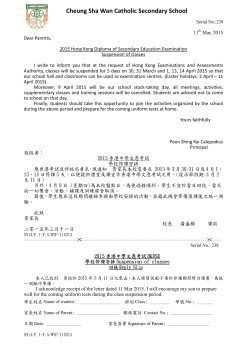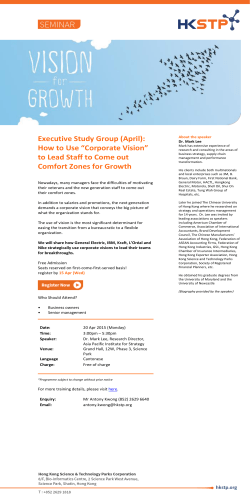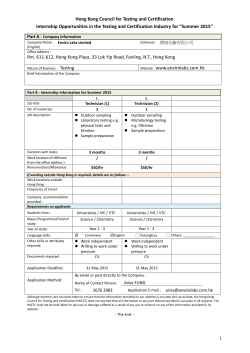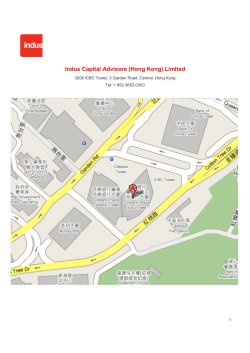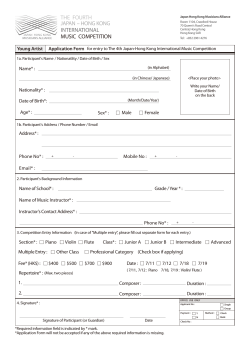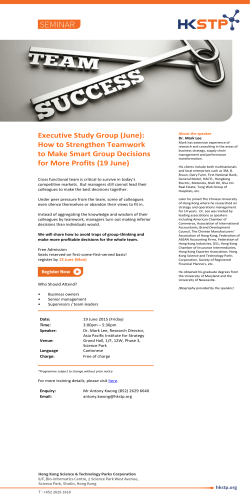
Through Train Update 0415 - Pine River Capital Management
THROUGH-TRAIN P I N E R I V E R C A P I T AUPDATE L MANAGEMENT OVERVIEW APRIL 20152015 APRIL THE COMRADES ARE IN TOWN Talk to most Hong Kong residents about a powerful and unstoppable southbound force reaching their shores, and they’ll likely picture People’s Liberation Army troops marching down the Queen’s Road. That is obviously not the case these days, but there is indeed something very powerful starting to arrive in Hong Kong from the north as investment capital is finally travelling along the southbound route of the Through-Train. The Shanghai-Hong Kong Connect program, more commonly known as the Through-Train, launched last November to enable Chinese onshore investors to freely access a large subset of Hong Kong-listed shares and vice-versa. Developments in the market since then have been dramatic, with a strong bull market in Shanghai and a drastic reversal of the long-standing discount between dual-listed Shanghai A-shares and Hong Kong H-shares. For several months, “northbound” traffic (offshore capital moving toward onshore Chinese markets) was heavy while “southbound” traffic (onshore China capital moving into the Hong Kong market) was scant at best. More recently however, the speculative flow of capital has turned and investors may finally be deciding that Hong Kong could be a more attractive destination. On March 27, the China Securities Regulatory Commission (CSRC) announced that Chinese mutual funds – which had long been restrained by the QDII quota system in their purchases of Hong Kong-listed stocks – would have that restraint lifted under the Through-Train program. How big of a deal is this? By some estimates the fund management business in China is on the order of RMB5 trillion. Considering that the average total daily trading volume on the Hong Kong Exchange was an anemic HK$50-60 billion prior to this announcement, even a tiny fraction of onshore fund capital flowing south toward Hong Kong is analogous to a flash flood of fresh capital washing into its market. Adding to this good news, the CSRC followed up with another directive permitting Chinese insurance companies – with roughly RMB10 trillion under management – to invest in a broader range of overseas equities, particularly those not listed on major exchanges. Having dramatically pushed up China’s domestic growth stock indices from late 2014 through the first quarter of 2015, Chinese investors are now looking southward. Overnight, we saw vibrant signs of life emerge in the long dormant Growth Enterprise Market (GEM – a sidekick of the Hong Kong Exchange that hosts growth companies that do not fulfill the main board’s listing requirements). Soon after the Easter holidays, daily trading volumes in Hong Kong swelled to five times their long-term average. The Hong Kong dollar, which is pegged to the U.S. dollar within a tight band, was pinned at the top of that band in a strong sign that overseas money was coming into Hong Kong. Together, these phenomena bear all the hallmarks of a flat-out fight for shares, a scene not unlike 2007 when the Hang Seng Index jumped 50% within a few months of an announcement by Beijing that it was ready for a “direct link” allowing mainland capital to invest in Hong Kong. (This particular scheme did not materialize due to a combination of internal disagreements within China and the onset of the Global Financial Crisis.) FUNDAMENTALS OR FUND FLOWS? Between the fourth quarter of 2014 and the first quarter of 2015, the Hang Seng Index returned a respectable 8% while the HSCEI, an index of mainland companies that also list H-shares, had a much better showing at 18%. Both were outshone by the Shanghai and Shenzhen bourses, broadly represented by the CSI300 index, which rose 63%. Predictably, the A/H price differential for dual-listed companies turned an A-share discount into a sizable A-share premium. Theories abound about these fireworks in the Chinese stock markets. Many observers would like to point to an improvement in earnings to justify the sky-bound trajectories of A-shares. Indeed there was a neardoubling of earnings for companies in sectors such as securities brokerages that saw a big pickup in trading volumes, insurance companies which benefitted from exposure to the stock market, and other select fields such as e-commerce. However, for typical CSI300 index components such as banks, real estate developers and manufacturers, the main story is one of slowing growth and a murky outlook. Yes, investors have reason to be optimistic about the reform agenda of the Xi-Li administration bearing economic fruit down the road, but is that tangible enough to justify the euphoria blanketing virtually all brokerage firms in mainland China? Thus far, the data we see at the macro level still seems to point to a soft economy for at least a few more quarters, and some at the People’s Bank of China (PBOC) are still issuing dire warnings about the possibility of deflation. THROUGH-TRAIN UPDATE PINE RIVER CAPITAL MANAGEMENT OVERVIEW APRIL 2015 PBOC governor Zhou Xiaochuan recently lent credence to one particular school of thought that holds the government responsible for a “manmade” bull market when he commented that “I am personally opposed to the view that money should not flow into the stock market, as if funds in the stock market are not supportive of the real economy.” The real question, however, is not whether Beijing would like to see a vibrant securities market, but whether the government’s blessing is sufficient on its own for triggering a full-fledged bull market. In fact, over the course of the preceding multi-year bear market, the central government had held a very pro-market stance and even bought shares of state-owned enterprise (SOE) banks and insurance companies from time to time. Yet it wasn’t until the past two quarters that a bull market finally emerged. Another popular hypothesis relates to the mythic powers of “Chinese Aunties” (中国大妈), a popular term used to describe retail investors who are said to be behind the waves of fresh money flooding the Chinese equities markets. Even if we were to believe that they were the engine behind the stock rally, it would be useful to understand what precipitated the Aunties’ overnight transformation from cautious savers to daring risk-takers. What we do know is that the bull market that started in 2014 most likely did not originate with traditional providers of speculative money such as managed funds, securities firms, and the insurance industry. The catalyst that unlocked a portion of the huge store of savings (estimated to be RMB113 trillion as of the third quarter of 2014) in the banking system would appear to be wealth management products (WMP). These are higher-yielding products offered by financial institutions to savers which serve to circumvent rules that cap the deposit interest rate for normal bank CDs. While total bank deposits started to show zero or negative growth by the second half of 2014, the size of WMPs was growing at a brisk pace of RMB1.5-2.0 trillion a month, and by the end of 2014 the total amount of WMPs reached roughly RMB18 trillion. Regulators, in an attempt to limit the impact of “shadow banking” on the real economy, capped the amount that WMPs could invest in “nonstandard” targets (e.g. loans to real estate companies) to 35%. That left 55%-60% in fixed-income investments and 5%-10% in equity-type investments. In short, if our back-of-the-envelope calculations are in the ball park, an estimated RMB 1 trillion was looking for a place to park in the equities universe in late 2014. There certainly wasn’t enough room to absorb it all in the total RMB500 billion in IPOs and SEOs issued in 2014. In a November 2014 investor note, we commented: “In the initial phase of the bull market, we anticipate that an eruption of trading volume will disproportionally benefit brokerage stocks and other non-banking financials such as insurance companies. Theoretically, many of the firms listing in Hong Kong would benefit from the same narrative in the foregoing discussion. However in the short run at least, because the Shanghai market is more driven by fund-flow and prone to trend-chasing it is likely to out-perform its Hong Kong counterpart by more than can be justified based on a simple valuation basis. Therefore, it is more profitable to bet long on Shanghai more so than on Hong Kong in the first stage of this bull market. Going forward, if the performance gap between the indices in China and in Hong Kong continues to widen, we will need to look out for possible convergence plays.” Fully recognizing the foolhardiness of attempting to predict the extent/length of any bull market, we are fairly comfortable in our belief that Ashares have now absorbed the bulk of the euphoria we expected in the first stage of this bull market. Further, the A/H performance gap might also have reached a local high as of the end of March. As far as convergence is concerned, one year ago we acted on our view that the discount between A-shares and H-shares would shrink. At this point, we are going the other way and suggesting that the next round of profits will come from an anticipated narrowing of the rich premium that has emerged between A-shares and H-shares. Of course, there are a range of attractive investment opportunities presenting themselves in China at present. But strategies targeting the large movements of capital flowing between newly-opened onshore and offshore markets are among the most timely and scalable. It’s likely that history will view the Through-Train as a cornerstone of the broad market reform agenda of the Xi-Li administration and a major step forward in the evolution of China’s economy. Seeing traffic emerging on its southbound route is a highly encouraging step toward that legacy.
© Copyright 2026



